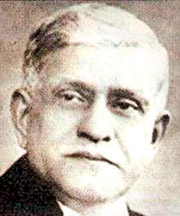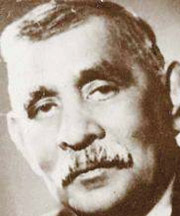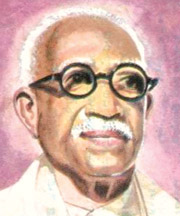Creators of Modern Education in Sri Lanka
Nalaka Gunawardene & Vindana Ariyawansa
 Sri Lanka's formal education system is the product of decades of
public investments by successive governments, complemented by over a
century of painstaking work by a large number of teachers, school
principals, philanthropists and others. Imperfect though it may be, the
education system is one of the greatest social assets of the nation. Sri Lanka's formal education system is the product of decades of
public investments by successive governments, complemented by over a
century of painstaking work by a large number of teachers, school
principals, philanthropists and others. Imperfect though it may be, the
education system is one of the greatest social assets of the nation.
In today's Wiz Quiz, we look back at some of the key individuals and
institutions that helped create that legacy.
|

The Ryukyu Kingdom |
1. The American national Col Henry Steel Olcott (1832 - 1907) is a
revered figure in the history of Buddhist revival and education in Sri
Lanka. He was initially trained in agriculture, and then excelling in
both law and journalism, he had a distinguished career in the military
and government before taking to full time spiritual advocacy and
cross-cultural understanding. Working with like-minded Lankans, he was
instrumental in starting leading Buddhist schools in Sri Lanka such as
Ananda College in Colombo, Mahinda College in Galle and Dharmaraja
College in Kandy. What was the non-governmental organization that was
founded in New York, United States of America (USA), in 1875 that
provided the institutional framework for all this Buddhist educational
activity in Ceylon, right under the nose of British colonial rulers?
2. C W W (Christopher William Wijekoon) Kannangara is fondly
remembered and saluted as the founder of free education in Sri Lanka.
The progressive policy created many opportunities for talented young
people to pursue their studies to university level without having to pay
school fees. He was the first chairman of the Executive Committee of
Education in the State Council of 1931 (equivalent of minister today),
and was instrumental in introducing extensive reforms to the country's
education system. He also started the central schools scheme, which
established high quality secondary schools in rural areas. Where was the
first ever central school established, first among several dozen?
3. Education reformer C W W Kannangara confronted strong opposition
to create a free education system in Sri Lanka. He delivered his speech
for six and half hours to convince the members of the State Council to
vote for the bill. There was also a public campaign launched by
educationists like Dr E W Adikaram, Dr. G P Malalaekera and L H
Meththananda to support the bill which was eventually passed in July
1945. Meththananda and Malalasekera, along with Sir D B Jayatilaka, had
all headed a leading Buddhist school for boys set up by Col Olcott in
1886. What was this school that figured prominently in Buddhist
education and cultural revival in Ceylon?
|

Col Henry Steel Olcott |
4. C W W Kannangara joined Anagarika Dharmapala's Temperance Movement
and actively worked with its leaders including Sir D B Jayatilaka, D S
Senanayake and F R Senanayake. There was another prominent leader in
this group who was a planter by profession. He was also a philanthropist
and an independent activist of Ceylon who was known for the jack-fruit
propagation campaign he pioneered throughout the country. Nicknamed "Kos
Mama," he also helped a number of educational establishments in the
country. Who was he?

Sir D B Jayatilaka |

D S Senanayake |

C W W Kannangara |

Kathryn Bigelow |
5. Sir D B Jayatilaka (1868 - 1944) was a leading scholar,
educationist and later diplomat in pre-independent Ceylon. He first met
Col Henry Steel Olcott in 1890 and joined his campaign to establish
English medium Buddhist educational institutions across Sri Lanka. In
1898, he became the principal of a Buddhist High School in Kandy that
Olcott and his associates had founded in 1887. By what name is this
leading school known today?
6. Edward Winifred Adikaram (1905 - 1985), better known as Dr E W
Adikaram, was an eminent educationalist, writer and a social activist in
Sri Lanka.
He established several schools including Anula Vidyalaya, Nugegoda,
and groups like the Young Thinkers' Club, the Vegetarian Society of Sri
Lanka and the Krishnamurti Centre. He wrote series of school texts on
general science and many newspaper articles on a range of subjects
including social criticism, physical and environmental sciences. Dr.
Adikaram also edited a Sinhala magazine that was demystifying and
popularizing science. What was its name?
7. He was the first cabinet minister of education in Ceylon from 1947
to 1954, and later served as the cabinet minister of health. He was a
reservist officer in the Ceylon light infantry and as the education
minister, moved forward work started by C W W Kannangara in reforming
and expanding state schools. Who was he?
8. Dr T B (Tuan Burhanuddin) Jayah was a Lankan educationalist,
politician and a diplomat. He entered politics in 1924 and was elected
to the Legislative Council to represent the minority communities. From
1936 to 1947, he served in the State Council of Ceylon. Earlier, in
1921, he was appointed Principal of a leading Muslim boys' school in
Colombo and he was able to develop it to the standards of other leading
schools and also established branches in Matale, Alutgama and Puttlam.
What was this school?
9. At the beginning of the 20th century, this wealthy Lankan widow
from Panadura was left in control of a vast fortune made in plantation
agriculture and liquor trade, part of which she used to found a school
for Buddhist girls in Colombo in 1917. Originally known as Buddhist
Girls College, it moved to its current premises at Vajira Road, Colombo,
in 1927 and became known as Visakha Vidyalaya. Who was the school's
founder, whose life story was written in 1997 by journalist Manel Tampoe
under the title "Buddhist Female Philanthropy and Education"?
10. Trained in mathematics and armed with a masters degree in
education, this scholar became the first Lankan Professor of Education
in 1957, and also served as Head of the Department of Education at the
University of Ceylon. The department was set up as a result of a
recommendation made by the Special Committee of Education (1943)
popularly known as Kannangara Committee. He chaired the country's first
ever commission of education appointed in 1961, and proposed far
reaching reforms on many areas of education. He also produced 12 Sinhala
textbooks in mathematics in a simplified form for the benefit of
students and teachers, which were popular in schools for two decades.
Who was he?
11. It is Japan's third largest city, located at the mouth of the
Yodo River and is one of Japan's commercial and industrial hubs. This is
where its famous namesake castle, once one of Japan's largest.
The castle was built in 1586 by the warrior general Toyotomi
Hideyoshi, but what visitors see today is a reconstruction because the
original was later destroyed. What is this city?
12. The Ryukyu Kingdom was an independent monarchy that reached its
economic height in the 15th and 16th centuries. Despite its small size,
the kingdom played a central role in the maritime trade networks of
medieval East and Southeast Asia.
Ryukyu established tribute state relations with China and sent their
trade ships as far away as Indonesia, Malaya, Ceylon and even Africa.
The Kingdom was taken over by the feudal domain of Satsuma at the
beginning of the Edo Period, and was eventually made a prefecture of
Japan in modern times. The seat of the Ryukyu Kingdom is known by what
name today?
13. After winning an Academy Award for The Hurt Locker in 2009,
American filmmaker Kathryn Bigelow is back with a docu-drama about Osama
bin Laden. It centres on the US Navy Seal unit that raided bin Laden's
compound in northern Pakistan in 2011. What is this film's title,
directed by Bigelow and written by Mark Boal?
14. "Ranchagoda Lamaya" was the name of a daily column in the form of
a two stanza poem that was highly popular in the daily Sinhala newspaper
Aththa (now defunct), owned and published by the Communist Party of
Ceylon.
The versified column was heavily laced with biting sarcasm and
criticism of whomever was in power, and had a wide following during the
1970s and 1980s.
Name the senior journalist, who was also a novelist, poet and radio
play writer, who wrote this column.
15. In the history of Test cricket which has been an international
sport for over a century, only one batsman has the distinction of
hitting the very first ball of a test match for six runs.
This batsman is also one of the four Test cricketers to have scored a
triple century twice in their careers (the other three being Sir Donald
Bradman, Brian Lara and Virender Sehwag). Who is this batsman, who was
adjudged during the recent World T20 cup as "cricket's best entertainer
of the world" by a television (TV) poll?
Last week’s answers
1. Upper Kotmale Hydro power Project
2. Acura
3. Studio Ghibli
4. Jomon
5. The Tale of Genji
6. Portugal
7. Kyoto
8. Bushido
9. Sword
10. Todai-ji Temple
11. Kobe
12. Osaka
13. Steve Jobs
14. Pope Clement VIII
15. Edward L. Strate meyer |







